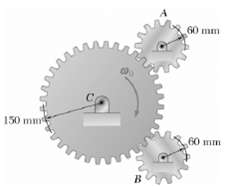Each of the gears A and B has a mass of 675 g and has a radius
Question:
Each of the gears A and B has a mass of 675 g and has a radius of gyration of 40 mm, while gear C has a mass of 3.6 kg and has a radius of gyration of 100 mm. Assume that kinetic friction in the bearings of gears A, B, and C produces couples of constant magnitude 0.15 N ?? m, 0.15 N ?? m, and 0.3 N ?? m, respectively. Knowing that the initial angular velocity of gear C is 2000 rpm, determine the time required for the system to come to rest.

Fantastic news! We've Found the answer you've been seeking!
Step by Step Answer:
Related Book For 

Vector Mechanics for Engineers Statics and Dynamics
ISBN: 978-0073212227
8th Edition
Authors: Ferdinand Beer, E. Russell Johnston, Jr., Elliot Eisenberg, William Clausen, David Mazurek, Phillip Cornwell
Question Posted:





